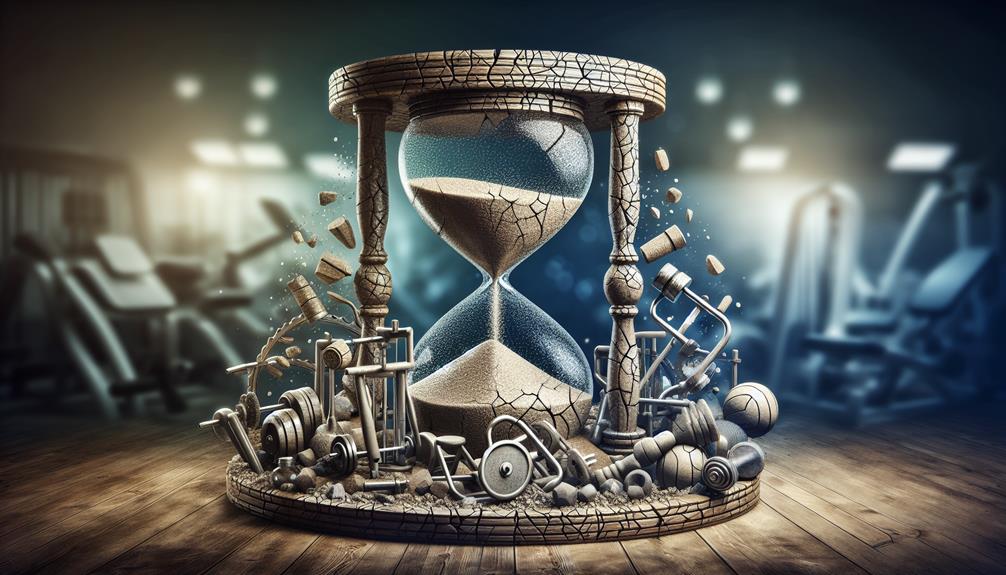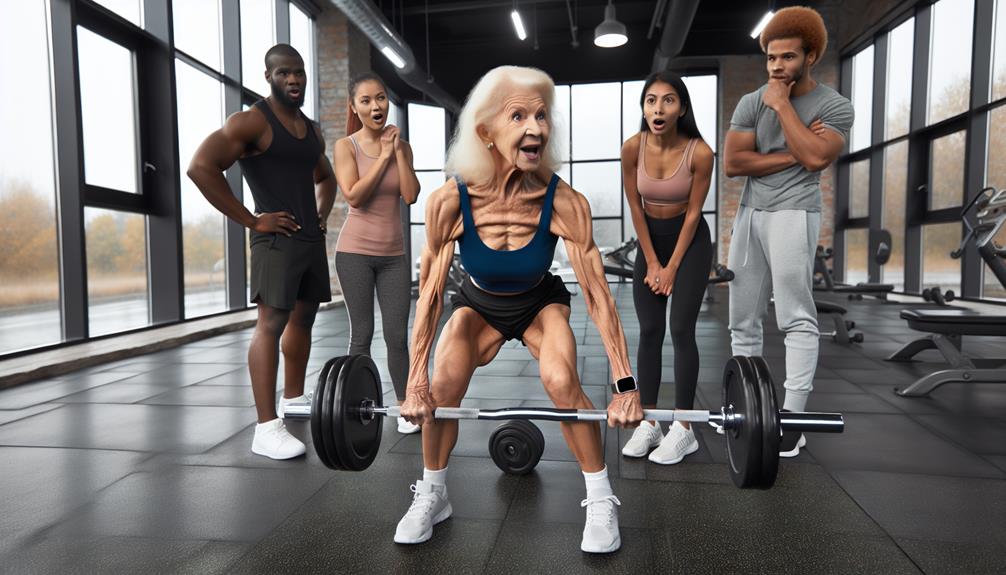
You've probably heard "no pain, no gain", but pain isn't what measures a good workout; safety and consistency are. Spot reduction is a myth; you can't control where your body loses fat. Getting fit isn't a quick fix, it requires dedication and patience. While protein is important, overconsumption doesn't lead to more muscle and could harm your kidneys. Cardio isn't the sole path to weight loss; strength training matters too. Other myths include seeing results with empty stomach workouts, stretching pre-workout, and believing age or daily workouts are necessities. Stick with us to separate more fitness fact from fiction.
'No Pain No Gain' Myth
Busting the 'no pain, no gain' myth, it's important for you to understand that enduring severe discomfort during a workout isn't a reliable indicator of fitness progress. Pain isn't a badge of honor, but a signal from your body that something might be wrong. Being in pain can be counterproductive to your progress. It can lead to injuries that set you back, rather than pushing you forward.
For an innovative approach to fitness, let's focus on 'no strain, no gain'. Exercise should challenge you, not harm you. It's fine to feel a 'burn' during a workout, that's your muscles working hard. But, if you're feeling sharp, stabbing, or sudden pains, it's time to stop.
Consistency, not intensity, is key to real results. It's not about how hard you can push yourself in one session, but how regularly you can get your body moving. By listening to your body and respecting your limits, you're more likely to stay motivated, avoid injuries, and make sustainable progress.
Spot Reduction Fallacy
You've probably heard about spot reduction, the idea that you can lose fat in specific areas by targeting those areas with certain exercises.
Sorry to burst your bubble, but it's time to debunk that myth.
Let's explore what spot reduction is, why it's a misconception, and introduce healthier, more effective alternatives for fat loss.
Understanding Spot Reduction
Delving into the domain of spot reduction, it's important to understand that this popular fitness myth, often referred to as the Spot Reduction Fallacy, suggests you can burn fat in specific areas of your body by simply exercising those areas. This notion might seem attractive, especially if you're seeking to perfect a particular body part. However, it's essential to comprehend the science behind fat loss to see why this concept doesn't hold water.
The body stores fat as a fuel reserve. When you work out, your body taps into these reserves across the entire body, not just the area you're exercising. It's a systemic, not localized, process. This fact is rooted in the way our bodies metabolize fat—breaking it down for energy happens throughout the body, not just in the muscles you're working.
Embracing this understanding can empower you with realistic expectations and strategies for your fitness journey. It's important to focus on total body fitness rather than aiming for spot reduction. Integrating a balance of cardio and strength training with a healthy diet is the innovative approach you should adopt to achieve sustainable fat loss and overall fitness.
Debunking Spot Reduction Myth
Now, let's debunk the myth of spot reduction to further enhance your understanding of effective and sustainable fat loss strategies. Spot reduction suggests that you can lose fat from a specific part of your body by exercising that area alone. However, this is a misconception. Your body loses fat uniformly, not from specific locations.
Here's why spot reduction is a fallacy:
- Your body's fat cells store energy for future use. When you burn more calories than you consume, your body taps into these reserves, reducing fat cells evenly across your body.
- Genetics play a significant role in fat distribution and loss. You can't control where your body decides to shed fat first.
- Fat loss is a systemic process. It involves complex hormonal and metabolic functions that are regulated by your body as a whole, not by individual muscles.
- Performing exercises targeting a specific area can strengthen the muscles there, but won't directly burn the fat overlaying those muscles.
Healthy Fat Loss Alternatives
Let's pivot to explore healthy alternatives for fat loss that debunk the misleading idea of spot reduction. Spot reduction, the myth that you can lose fat in a specific area by targeting it with exercises, has been proven to be scientifically inaccurate.
But don't fret, there are effective ways to lose fat healthily and comprehensively. Consider High Intensity Interval Training (HIIT), a versatile workout tactic that blends intense bursts of activity with short recovery periods. It's known to boost metabolism, improve cardiovascular health, and most importantly, promote fat loss throughout your body.
Next, think about implementing a balanced diet full of lean proteins, complex carbohydrates, and healthy fats. Combining this with regular physical activity ensures your body burns fat efficiently. Remember, it's not about starving yourself, but nourishing your body with the right nutrients.
Lastly, don't underestimate the power of adequate sleep and stress management. They play significant roles in regulating hormones responsible for fat storage. Neglecting these aspects can derail your fat loss journey.
Myth of Fast Results

You've probably been enticed by promises of rapid fitness results. However, these claims often foster unrealistic expectations and overlook the truth about quick-fixes.
Let's bust this myth and set you on a path towards sustainable, long-term fitness.
Unrealistic Fitness Expectations
In the domain of fitness, expecting quick results is a common yet misguided belief that can lead to disappointment and demotivation. You're not alone if you've ever hoped for drastic changes after a few sessions at the gym. However, such expectations are unrealistic and can hinder your progress.
Here are some key things to remember:
- Sustainable fitness is a marathon, not a sprint. It's about making continuous, small changes that add up over time.
- Your body is unique. What works for someone else mightn't work for you. Don't compare your progress to others.
- Consistency is the key. You can't hit the gym once and expect to see changes overnight. Regular exercise and healthy eating are the keys to long-term success.
- Be patient. True fitness takes time. If you're working hard and eating right, you're making progress, even if it's not immediately visible.
The Truth About Quick-fixes
Succumbing to the allure of quick-fixes, many people fall prey to the myth of fast results in fitness. You've probably seen programs promising to get you in shape in 7 days or supplements promising a six-pack with no exercise. It's tempting, but it's also misleading.
Fitness is a life-long journey, not a race. It requires consistency, dedication, and patience. Quick-fixes can't offer sustainable results because they don't foster the necessary lifestyle changes. They may give you temporary results, but they're often accompanied by health risks and the likelihood of rebound weight gain.
Don't be swayed by these shortcuts. Focus instead on creating a balanced, sustainable fitness plan that includes regular exercise and a healthy diet. Remember, it's not about the speed but the quality of the journey.
Innovation in fitness doesn't mean quick-fixes. It means finding new and effective ways to maintain a healthy lifestyle. Embrace the process, celebrate small victories, and don't compare your progress with others. Each step you take towards a healthier lifestyle is a triumph in itself.
Protein Overload Misconception
Let's debunk one of the most common fitness myths: the belief that more protein always equals more muscle. While protein is essential for muscle repair and growth, your body can only utilize a certain amount for these purposes. Consuming excessively high amounts won't automatically result in larger muscles.
In fact, protein overload can lead to health issues. Here are four things you need to know about this fitness misconception:
- Your body can only process a certain amount of protein at a time. Excess protein doesn't just magically transform into muscle; it's excreted or stored as fat.
- Overconsumption of protein can strain your kidneys, especially if you already have kidney issues.
- Consuming a balanced diet with adequate protein is key, not just loading up on protein shakes and bars.
- Incorporating strength training into your fitness routine is the most effective way to build muscle.
Cardio Is King Myth

Moving on, it's time to tackle the widely held belief that cardio exercises are the ultimate solution for weight loss. You've probably heard it countless times, 'to lose weight, do more cardio.' While cardio is an essential component of any fitness routine, it's not the pivotal and paramount when it comes to shedding pounds.
Contrary to popular belief, strength training can be equally, if not more, effective for weight loss. It helps build muscle, and muscle, in turn, boosts your metabolism. This means you'll be burning more calories, even when you're at rest. So, don't limit yourself to just the treadmill or the elliptical. Incorporate weight lifting into your regular workout routine.
Don't get us wrong. We're not downplaying the importance of cardio. It's critical for heart health and stamina. But it's imperative to understand that fitness isn't a one-size-fits-all scenario. Your body responds differently to different types of exercise. The key is to find a balance that suits your individual goals.
Women Bulking Up Myth
Busting another myth, many women fear that lifting weights will cause them to bulk up excessively, a misconception that's far from the truth. In reality, weightlifting is a powerful tool that can help you sculpt a lean, strong, and curvaceous physique.
Hormonal Differences:
Women naturally have 15-20 times less testosterone than men, the essential hormone for muscle growth. This significant hormonal difference makes it very difficult for women to 'bulk up' like men.
Metabolic Boost:
Weightlifting can greatly increase your metabolism, helping you burn more calories and fat throughout the day.
Muscle Definition:
Lifting weights doesn't make you big and bulky. Instead, it helps create more defined and toned muscles.
Bone Health:
Regular weightlifting can also enhance your bone health, reducing the risk of osteoporosis.
Empty Stomach Workouts
You've probably heard that working out on an empty stomach is the key to fat loss. However, before you cancel breakfast and hit the gym, it's important to understand the pros and cons of fasted exercise, the risks it might pose, and how to balance nutrition with your fitness goals.
Let's debunk the myths and lay out the facts about empty stomach workouts.
Pros of Fasted Exercise
Despite the common misconception, working out on an empty stomach, known as fasted exercise, can actually offer several unique benefits. It's a cutting-edge approach to fitness that might just revolutionize your workout routine.
Firstly, fasted exercise is noted for its ability to increase fat burning, as your body turns to stored fat for fuel when glucose levels are low. This is a game changer if you're aiming to shed some extra pounds.
Secondly, it can enhance your body's insulin sensitivity, making it more efficient at processing sugars and reducing your risk of developing type 2 diabetes.
Here are some other benefits of fasted workouts you mightn't have considered:
- Improved endurance: Your body learns to become more efficient at fueling workouts, potentially boosting your performance.
- Increased growth hormone production: Fasted exercise can stimulate the release of growth hormones, which aids in muscle growth and recovery.
- Enhanced metabolic functions: Your metabolism can become more efficient as it adapts to burning fat for energy during fasted workouts.
- Mental clarity: Some people report increased focus and mental acuity during and after fasted workouts.
Risks in Empty Stomach Workouts
Considering the benefits of fasted workouts may make it an enticing option, one must also take into account the potential risks involved in exercising on an empty stomach. You might be setting yourself up for a workout that's less effective or potentially harmful to your health.
One key risk is energy depletion. With no fuel to burn, your body turns to stored fat and muscle for energy, which can lead to muscle loss. Additionally, working out without eating first can lead to low blood sugar or hypoglycemia, causing dizziness, fainting, and weakness.
Below is a table highlighting some potential risks and their effects.
| Risks | Effects | Prevention |
|---|---|---|
| Energy Depletion | Muscle Loss | Proper nutrition |
| Hypoglycemia | Dizziness, Fainting | Eat before workout |
| Poor Performance | Inadequate workout results | Fuel body appropriately |
| Increased Injury Risk | Strains, sprains | Warm up properly |
| Decreased Immunity | Frequent sicknesses | Balanced diet and rest |
Balancing Nutrition and Fitness
Finding the right balance between nutrition and fitness is essential, especially when considering empty stomach workouts. You may think you're maximizing fat burn by skipping meals before exercise, but that's not always the best approach. Your body needs fuel to function effectively, and when it comes to fitness, it's all about timing and the right choice of nutrients.
Consider the following tips to strike the right balance:
- Eat a small, protein-rich snack about an hour before your workout. This gives your body the fuel it needs without weighing you down.
- Stay hydrated. Water is your best friend during any kind of workout, and it's especially important when you're exercising on an empty stomach.
- Listen to your body. If you feel dizzy or fatigued, it could be a sign that you're not getting enough nutrients.
- Post-workout, replenish your body with a balanced meal. This should include protein for muscle recovery, carbs to replenish energy stores, and healthy fats for overall health.
Balancing nutrition and fitness isn't about deprivation. It's about providing your body with the nutrients it needs to perform and recover effectively. Remember, innovation in fitness isn't just about pushing boundaries, it's also about understanding and catering to your body's needs.
Stretching Pre-Workout Myth
You've likely heard the common advice to stretch before a workout, but recent studies suggest this might not be as beneficial as once believed. Instead, you might be better off warming up with light cardio as it increases blood flow, raises body temperature, and prepares your muscles for the workout ahead.
Let's break this down with a simple table:
| Traditional Belief | Current Understanding |
|---|---|
| Pre-workout stretching prevents injury | No concrete evidence supports this |
| Stretching enhances performance | Stretching pre-workout can actually lower strength and speed |
| You should hold stretches for long periods | Short, dynamic stretches are more effective |
| Stretching increases flexibility | Flexibility is increased more by consistent exercise |
| Everyone needs to stretch pre-workout | It's highly individual, depending on your workout and body |
The bottom line? Listen to your body. If pre-workout stretching feels good and helps you get in the zone, there's no harm in doing it. But if you're stretching solely to prevent injury or enhance performance, you might want to reconsider. Opt for a dynamic warm-up instead, and leave the stretching for your cool-down.
Myth of Age Limitations

Often, people mistakenly believe that age is a barrier to engaging in regular fitness activities. This myth, pervasive as it is, can keep you from reaping the numerous benefits of living an active lifestyle.
You may have been told that you're too old to start working out or that physical activity could be dangerous for you. Let's debunk these misconceptions with some solid facts:
- Age isn't a fitness barrier: Many studies have shown that adults of all ages can improve their health and well-being through moderate, regular physical activity.
- Strength training is beneficial: Regardless of your age, strength training can enhance your muscle mass and bone density.
- Physical activity boosts mental health: Regular exercise can help manage symptoms of depression and anxiety, regardless of your age.
- It's never too late to start: Even if you've been sedentary for years, you can still benefit from adopting more active habits now.
Daily Workouts Necessity Myth
Believing you must work out every single day is another widespread fitness myth that needs debunking. You might think that more is always better, but when it comes to exercising, that's not the case. Your body requires rest to recover, repair, and build strength.
In fact, overdoing it with daily, intense workouts can lead to overuse injuries and hinder your progress. It's about working smarter, not harder. Incorporating rest days into your routine isn't only beneficial, but essential for peak performance and results.
Consider this innovative approach: Instead of daily hour-long workouts, aim for three to five sessions per week, varying the intensity and type of exercise. This strategy can lead to better results than daily workouts, while reducing the risk of injury and burnout.
And remember, it's not just about quantity, but also quality. Make sure each workout counts by focusing on form and intensity rather than just ticking off a daily box.
Frequently Asked Questions
What Is the Ideal Frequency for Strength Training Workouts?
You've asked about the ideal frequency for strength training. Ideally, you should engage in strength training workouts 2-3 times per week. This allows your muscles ample time to recover and grow stronger.
Is It Necessary to Take Rest Days in Between Workouts?
Definitely, it's vital to take rest days. They allow your muscles to repair, rebuild, and strengthen. Without them, you're prone to injuries, fatigue, and even interference with your muscle-building progress. Don't skip rest days!
How Does Hydration Affect Physical Performance and Fitness Results?
Proper hydration greatly boosts your physical performance. It regulates body temperature, lubricates joints, and aids in nutrient transport. Without adequate water, you'll fatigue faster, hindering your workout results. So, always keep your water bottle handy.
Are There Specific Exercises for Targeting Belly Fat?
No, there aren't specific exercises to target belly fat. You can't spot reduce fat; it's a myth. Instead, focus on a mix of cardio, strength training, and a healthy diet for overall fat loss.
How Does the Intake of Carbohydrates Affect Muscle Growth?
Surprisingly, carbs aren't your enemy. They actually fuel your workouts and aid in muscle recovery. Consuming adequate carbs post-workout can stimulate insulin, promoting muscle growth. So, don't shun them from your muscle-building regimen.



